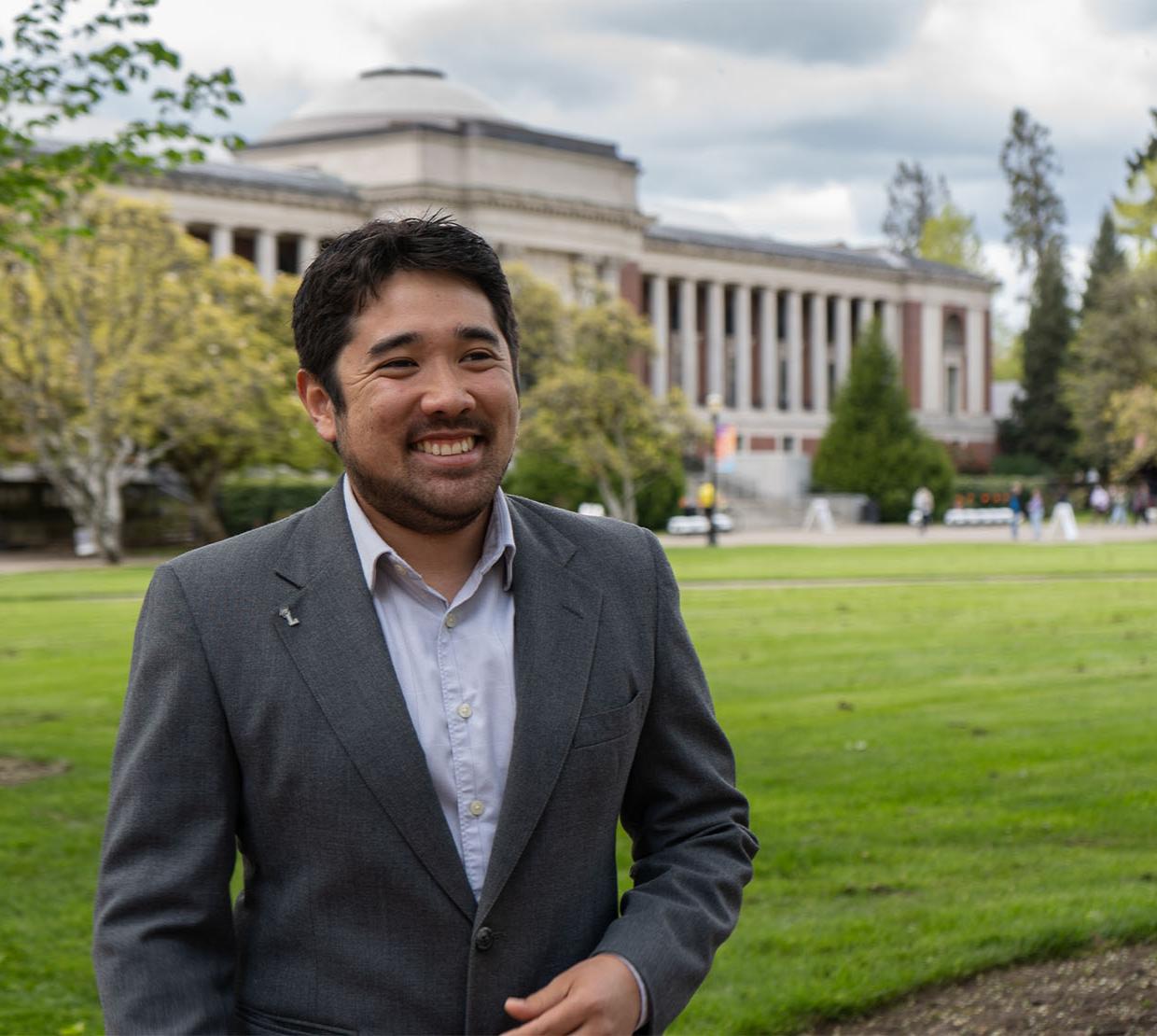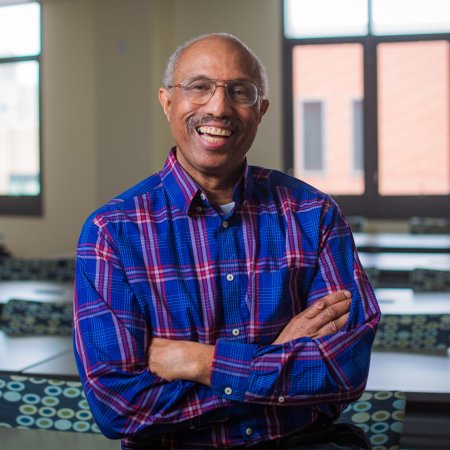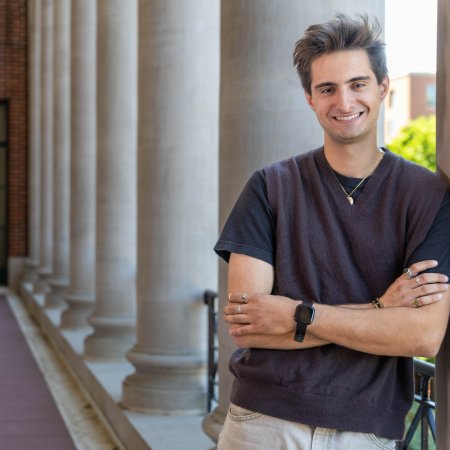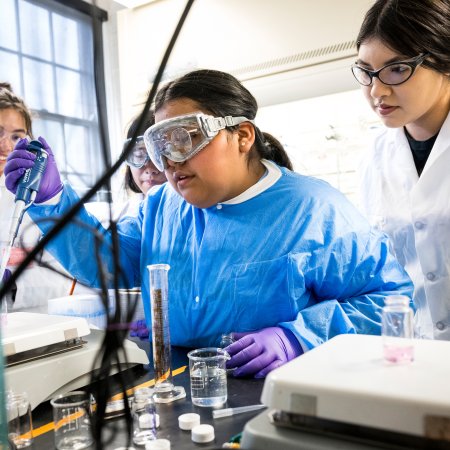The College's first director of equity access and inclusion discusses how collaboration, transparency and accountability will build a more diverse and equitable College of Science. Embedding Equity, Access and Inclusion is the College’s Strategic Diversity Action Plan. The first proposed action in the plan is to create a College of Science Equity, Access and Inclusion Program that included hiring a full-time EAI program director.
Authored by the Diversity, Equity, Justice and Inclusion Working Group, the Diversity Action Plan is a community plan, reflecting the many priorities and values of our community members deliberated in dialogue over the 2020–2021 academic year.
What are the opportunities and challenges you face as the director of EAI in trying to advance the new Diversity Action Plan?
Kameron: The College is in a good position to start doing this work. There is a lot of want, and there is a lot of energy around doing equity work. All the College departments already have committees working on this and planning to do this type of work. The opportunity here, in my mind, is to enhance that work, and then to work on culture change.
This is part of a bigger national conversation that is happening around how we change the institutional culture to one that is equitable, welcoming and inclusive of students who have marginalized backgrounds, as well as those who have historically been excluded from higher education.
One challenge with all of this, is that culture change work is slow. We have a foundation and are heading in a good direction, but this work moves slowly – and it is not checkbox based. It will take time, care and understanding. While directed support and programming for various groups is essential, we can't just say we did a program for Black students, or we did a program for folks who identify as women, then check the box and say that we changed the culture.
Another challenge is that change happens slowly in institutions that value shared governance, like ours. That means we make many decisions as a community, which takes time. The Diversity Action Plan (DAP), for example, was created with extensive input from the community, and its creation was a year-long effort. The upside is that the DAP is a community plan with wide ownership and commitment.
We can't just say we did a program for Black students, or we did a program for folks who identify as women, then check the box and say that we changed the culture.
We also need to be mindful to make changes in ways that are sustainable and long-lasting and tailor our steps accordingly. I would love to see nimble change that happens quickly. But we need to be deliberate about our processes to ensure that changes don’t have unintentional, harmful consequences and to make changes in ways that are beneficial to those who are being marginalized.
In light of all this, it may be challenging to effectively convey to the community that we are working on creating change, but know that we are. I hope to communicate progress without implying that we have all of the answers or that because we did something, that everything is “fixed.” This process and the DAP are iterative and will take continual progress to change culture.
What do you think will be the most important outcome of the plan?
Kameron: I think the most important outcome is eventual culture change. I would like to see equity and access become second nature to us – something we don't actually need to think about. It will just be a part of who we are and how we do business as a normal day-to-day thing. My hope, and this is super-long looking, is that my position becomes obsolete.
Now, is that anywhere near the case now? No, not really – but I think that's the goal we're working toward. A change in culture from, "Oh, that's right. We have to think about equity. How do we add equity into this?" To, "Oh, we've already thought about that. It was the first step. This was integral to the process and how we do things."
Again, that's a slow process. It will take continual pushing and prodding and making sure that we're reminding folks again and again. It's like learning to tie your shoes. You’ve got to practice.
Is that going to be a long-range goal and outcome? Absolutely. Along the way, an important outcome will be that folks who have marginalized identities or backgrounds are able to see progress.
I really want to push back on this idea that I'm going to come in here and fix racism in two days or in two years, and then racism will be gone. My hope is that, over time, people do see progress and people do see a difference in how they are perceived and how they engage with the College.
I would love to see more diversity in the faculty ranks, in the graduate school ranks, the undergraduate ranks, and the staff and professional faculty ranks, as well. But alongside that, there also needs to be culture change so that when those folks do come here, they feel welcome and want to stay here.
What is the community's role in fulfilling the plan, and how will you help facilitate this?
Kameron: This is a really important question for me because the community's role is to really buy-in and be a part of the solution. The Diversity Action Plan was written so that everyone has a role. I think everyone should be thinking about how in our day-to-day work the DAP being infused and embedded into what we do.
What does that tangibly look like? I think it means thinking, how is my class inclusive? What types of words and language am I using? Am I being diverse in the literature and the people we're talking about? Who are the pioneers of color or women in this field, and are we talking about them and their contributions?
But it’s also thinking about how we are engaging. What are our processes? What are our policies? Do they equitably support students, faculty and staff who have historically been excluded or marginalized in higher education? Are we saying, "Yes, we're going to be equitable, but not equal, because equity is inherently unequal."
Equity and equality are different. Equality means everyone is treated the same exact way, regardless of differences. Equity means everyone is provided with what they need to succeed.
As far as my role in facilitating this, my hope is that I am a resource for everyone in the College. I'm not the content expert on any of the classes being taught. But I am happy to join in conversations and engage in education and learning around how we can make the College of Science more equitable.
What are a few primary areas of focus for you right now?
Kameron: Two areas we are really focusing on now are holistic admissions for graduate students and the graduate teaching assistant (GTA) training process. Concerning the admissions process, we are asking: What does the graduate admissions process look like now, and what should it look like in the future? We are working to develop and share out a set of recommendations for this.
We are reviewing the GTA training process recognizing that a lot of our undergraduates engage with GTAs. We want to provide training and support for GTAs to be inclusive, to think about inclusivity and equity as they engage with students and others across campus. So, we are providing opportunities for training that can be worked into demanding schedules and responsibilities they already have in place this year.
Our Equity Data Collection sub-committee is also working hard to gather and analyze the baseline data outlined in the DAP.
There are a lot of conversations taking place as I engage in different places across the College of Science. Many of these involve working directly with a specific faculty on how to make a process or situation more equitable.
How will progress be communicated to the community?
Kameron: My hope is to be really transparent and communicate regularly, but in a way that is accessible and helpful without being excessive. We are still working on how to make this process most effective. I don't want my messages to be put in someone's junk folder because I send too many out. I want to make sure that we are communicating back out to the community what's going on, what are we working on, where the progress is being made, and ways people can engage. We will be creating a listserv for folks who want to get more frequent updates and to learn about opportunities to engage in learning and education around EAI.
I will be sharing regular updates and reports out to the College leadership team, the dean, and the community and stakeholders, as well as regular communications to the community. These messages will be shared in the EAI website’s “From the Director” page, and information about updates will also be shared via the Diversity Action Plan website.
It is also just as important that communication goes the other way, too. I want to hear from the community. I want to hear from the departments. I want to hear from faculty. I want to hear from staff. I want to hear from students on how they are being affected and what changes they see that could be made. Then, also, I want to hear feedback about the progress that we are making – how is it affecting you? Are the supports that we are putting in place helping to support you? Are they focusing on the right things?
A lot of times, we tend to focus on the numbers, such as adding more diverse students. But what that data doesn’t tell us is whether or not we're really supporting them. There's a myriad of reasons why we would want to add to the numbers of a specific group, but it is important that the numbers grow because we put the necessary supports in place.
In the future, surveys will be sent out from me and our Equity Data Collection Committee to engage folks and to hear their input. The College’s feedback form is also still available, and I am chairing the report intake committee now. Reaching out directly through the feedback form in an anonymous way is one way for people to let us know what's going on and what they might want to see happen.
While the College has a lot of work to do, I think it is poised to make changes that will positively impact the members of our community, specifically those that have historically been marginalized or excluded from higher education and science. I’m excited to be leading the College in this effort and working with everyone in the community to make change a reality. Everyone has a role to play. I ask that everyone think about and implement small steps, big changes and ways to change the culture for the better.




